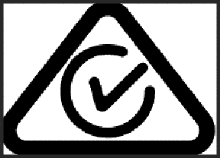
EESS - RCM - ACMA ( Regulatory Compliance Mark)
The RCM is used to show that products meet Electromagnetic Compatibility (EMC), Electromagnetic Radiation (EMR), Radio communication, Telecommunication and electrical safety legislative requirements.
We undertake all RCM processes for our clients including evaluation of existing test reports, testing, design for compliance, preparation of all documentation and assistance with registration on the EESS/ACMA database.
It is not a requirement that the required testing be conducted in Australia. However, it is a requirement that only Australian registered companies can register as Responsible Suppliers and gain permission to use the Regulatory Compliance Mark.
In addition, while CE Marking and similar are not accepted in Australia the test reports and technical data used may be used in part or whole. This includes testing to IEC/EN/CISPR/ETSI standards. All that is required is technical assessment supplemented by a report and where required partial additional testing to address the Australian requirements. We do this and have successfully done so for the last 30 years. We offer both the technical solution and all administrative requirements such as preparing the compliance folder and declarations.
The use of the RCM by the ACMA and the EESS
ACMA - Australian Communication and Media Authority. This is the regulator for matters in relation to Electromagnetic Compatibility, Radio Communications, EMR (Exposure to RF fields) and Telecommunications.
EESS - Electrical Equipment Safety Scheme. This is the scheme in place for electrical safety approvals.
There is NO connection between the ACMA and the EESS apart from the use of the RCM (regulatory compliance mark).
Step by step guidance for the ACMA's use of the RCM
Step 1. Does your equipment contain electronic and/or electrical components? If yes then go to step 2. If not then the ACMA's regulations do not apply.
Note that the ACMA's regulations cover electronic and electrical equipment for ALL environments. This includes domestic, commercial, light-industry and industrial. The ACMA's regulated environments are wider in scope than that of the EESS (see below)
Step 2. Determine which of the mandated standards applies to the equipment.
The ACMA has published this list on their website. A common misconception is that testing must be conducted at Australian test labs. This has never been a requirement.
Step 3. Prepare a compliance folder that includes a test report, technical report, product description and photograph and a Declaration of Conformity.
Step 4. Register as a Responsible Supplier with the ACMA and mark the product with the RCM.
Step by step guidance for the EESS use of the RCM
Step 1: Is your equipment in scope or out of scope?
In scope means:
- rated at a voltage greater than 50 V AC RMS or 120V ripple-free DC; and,
- rated at a voltage less than 1000V AC RMS or 1500V ripple-free DC; and
- is designed or marketed as suitable for household, personal or similar use
Out of scope means your product falls outside of these limits and definitions. If it is out of scope go to Step 3 otherwise go to Step 2 for in scope.
Step 2: If it is in scope first go to AS/NZS 4417.2 and find out what risk level (1,2 or 3) your equipment falls into.
Then go to step 2a
Step 2a: Apply the process for the risk level that applies to your equipment
- Level 1 – Evidence of compliance with the relevant standard + (Certificate of Suitability – Optional)
- Level 2 – Evidence of compliance with the relevant standard + Compliance Folder + (Certificate of Suitability – Optional)
- Level 3 – Evidence of compliance with the relevant standard + Certificate of Conformity – Mandatory
Evidence of compliance includes suitable test reports. It is not a requirement that the testing be conducted in Australia. Often in the evidence of compliancethere is supplementary technical assessments of existing test data and in relation to variants as test data can be extended to cover several models.
Then go to step 2b
Step 2b: Register as a Responsible Supplier on the ERAC database. Enter the information required for the risk level that applies to your equipment. Prepare a compliance folder that includes the test report, technical report, certificate of suitability or approval, product description and photographs. Mark the product with the RCM.
https://equipment.erac.gov.au/Registration/Default.aspx
End for in scope
Step 3: If your equipment is out of scope apply AS 3820 and the applicable standard as referenced in AS 3820. Do not mark with the RCM. Do not register as a Responsible Supplier. Do make a Compliance Folder. A compliance folder contains a description of the equipment, photos and technical data including test data.
End for out of scope
© Copyright Stradia